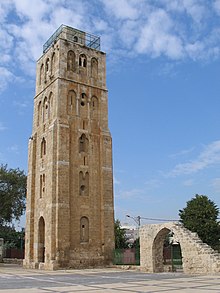
Back المسجد الأبيض (الرملة) Arabic المسجد الابيض فى الرمله ARZ সাদা মসজিদ, রমলা Bengali/Bangla مسجد سفید (رمله) Persian המסגד הלבן (רמלה) HE व्हाइट मस्जिद, रामला Hindi Masjid Putih, Ramla ID Moschea Bianca (Ramla) Italian Ош мечеть (Рамла) MRJ Witte moskee Dutch
| White Mosque | |
|---|---|
المسجد الأبيض המסגד הלבן | |
 Minaret of the White Mosque, 2006 | |
| Religion | |
| Affiliation | Islam |
| Location | |
| Location | Ramla, Central District |
| Country | |
| Geographic coordinates | 31°55′39.21″N 34°51′57.67″E / 31.9275583°N 34.8660194°E |
| Architecture | |
| Architect(s) | Umar ibn Abd al-Aziz |
| Type | Islamic |
| Style | Umayyad, Mamluk |
| Completed | 717 CE (enclosure); rebuilt by 1047; second phase 1190; third phase 1268 (minaret); rebuilt 1318 and 1408[1][2] |
| Specifications | |
| Dome(s) | 1 |
| Minaret(s) | 1 |
| Minaret height | 27 metres (89 ft) |
The White Mosque (Arabic: المسجد الأبيض, romanized: al-Masjid al-Abyad; Hebrew: המסגד הלבן, romanized: HaMisgad HaLavan) was an Umayyad-era mosque located in Ramle, Israel.[3] Only its minaret is still standing. According to local Islamic tradition, the northwestern section of the mosque contained the shrine of an Islamic prophet, Salih.[4]
The minaret is also known as the Tower of the Forty Martyrs.[5][6][7] Islamic tradition dating back to 1467 claims that forty companions of the Islamic prophet Muhammad were buried at the mosque, which influenced an erroneous[2] Western Christian tradition from the 16th century that the White Mosque was originally a church dedicated to the Forty Martyrs of Sebaste.[8][9]
- ^ Cite error: The named reference
HURIwas invoked but never defined (see the help page). - ^ a b Cite error: The named reference
Pringlewas invoked but never defined (see the help page). - ^ Centre, UNESCO World Heritage. "White Mosque in Ramle". UNESCO World Heritage Centre. Retrieved 18 December 2022.
- ^ Al-Abyad Mosque Archnet Digital Library. Archived 2013-09-18 at the Wayback Machine
- ^ Lamartine, A. de (1835). A Pilgrimage to the Holy Land. A. Waldie. p. 166.
- ^ Chateaubriand, F.-R. de (1814). Travels in Greece, Palestine, Egypt, and Barbary, During the Years 1806 and 1807. Van Winkle and Wiley. pp. 242.
- ^ Khalidi, Walid. Before Their Diaspora : A Photographic History of the Palestinians, 1876-1948. Washington, D.C.: Institute for Palestine Studies, 1991, 68.
- ^ George Robinson (1837). Travels in Palestine and Syria: In Two Volumes. Palestine. Colburn. p. 30.
- ^ Katia Cytryn-Silverman (2010). "The Mamluk Minarets of Ramla". Bulletin du Centre de recherche français à Jérusalem. 21.
